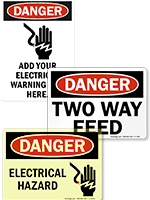This duration of illumination time, however, is indirectly proportionate with the brightness of the
photoluminescent sign. This means that the longer the photoluminescence period, the duller the light intensity during that time. Often there are two types of signs: a bright short-lasting kind, and a dim kind that can retain its luminosity for several hours. Emergency signs often use the brighter material, as it is imperative that the sign is seen quickly.
Photoluminescent material contains pigment molecules that, when exposed to light, absorb photons with wavelengths in the visible light range. In a process called photo-excitation, pigment molecules become excited, and emit photons back out of a lower energy level.
This happens when the electrons of the pigment molecule absorb light energy, move into their excited state, and then return to their lower-energy state. The extra energy released from the difference in electron excitation levels can be dissipated through the emission of light. Because the pigment molecules are rechargeable, this can happen over and over again. The absorption and emission process usually occurs in a matter of nanoseconds, but under special circumstances, it may take a few minutes or even hours. Photoluminescent signs are able to delay this process, thus making it able to remain bright after minutes or hours (as in the longer-lasting type of material).










 Lights on ...
Lights on ...
 Lights off!
Lights off!